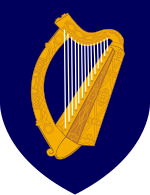Ireland/History
- Read the text.
- Can you help me and find some "Questions on the text?"
A BRIEF HISTORY OF IRISH EMIGRATION
Earliest times:
Irish monks, including St Kilian and St Gallus, leave Ireland to spread the Gospel. St Brendan sets sail in a small boat and is said to have reached America long before Columbus.
1603:
The Battle of Kinsale ends in defeat for the Irish at the hands of the English. The Flight of the Earls (1607) takes place as Irish leaders bid farewell to their native country. The Wild Geese - Catholic professional soldiers - depart to fight all over Europe.
1650-1700:
A steady stream of emigrants begins to places like Liverpool, the U.S. and Canada. Between 1730 and 1770 200,000 Ulster Protestants emigrate from Ireland. Settlers, soldiers, merchants, farmers and missionaries head off in search of a better life.
1845:
The Great Famine sparks off mass emigration from Ireland. Blight strikes the potatoes which were so vital for the day to day survival of the poor, uneducated Catholic farmer. Between 1845 and 1855 one million Irish starve to death and two million flee the country. Many emigrants do not survive the journey to America, dying in "coffin ships" on the way. Ireland provides America with 45 % of its immigrants at this time.
1850:
In Ireland people think more and more about leaving. They stop speaking Irish and switch to English. In America the Irish find work as railroad workers, tram conductors, soldiers, domestic servants and nurses. They help to build America. They send money home to help their families or to buy the passage over for brothers, sisters, cousins and friends. Some save up for their dream of buying a small farm in Ireland.
Datei:The sign of the Emigration - geograph.org.uk - 3954483.jpg
1900:
At the turn of the century three out of every four people born in Ireland will end up abroad[1]. Before they board the ships family and friends come together for the "American Wake" to say goodbye to sons and daughters they may never see again. All day and night they sing, dance, tell stories and drink to kill the pain. This tradition of the Wake continues for many years.
1900-1996:
Millions of Irish abandon Ireland.
1963:
John F. Kennedy, the finest example of an Irish success story abroad, visits Ireland.
1971:
A study shows 4,000 Irish doctors and 31,000 Irish nurses working in England at a time when there were only 3,000 doctors and 19,000 nurses in Ireland.
1988: With little prospect of work 45,000 people turn their backs on the country in a year when the number of births registered stands at a figure of 54,000.
2023: Today 40 % of all Americans and 30 % of Australians claim Irish roots. There are one million native Irish living in Britain. Every year thousands of Irish school children do the "Leaving Certificate Examination" and must then decide whether to stay in Ireland and look for a job or to take the boat or plane to a new life across the waves. 45 % of those who leave end up in England. Yet a new trend appears as many Irish abroad decide to retire to Ireland, buy a house and enjoy the last years of their life in the land of their birth. (519words)
- Fact File
- Geography
- History
- Traditions (typical customs and holidays)
- Irish Humour
- Limericks
- Planning a holiday
- ↑ abroad = beyond the bounds of a country; in foreign countries.





